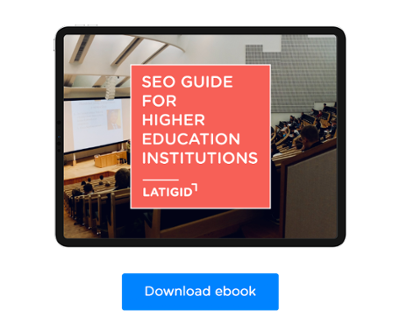
Today, parents' decision-making process regarding the choice of schools has changed radically. Schools are no longer the custodians of information, and this information is widely available on the internet. Today the decision process starts with a Google search.
1 – What is SEO?
SEO (Search Engine Optimization) is a practice used to increase the quantity and quality of traffic generated to a website through organic results in search engines. In other words, it's a way to put a company's website in the top Google results, getting more organic traffic to that website.
2 - How important is SEO in a school's marketing strategy?
The more traffic you have on your website, the more parents will know about your institution and the more interest it will generate. The more interest you generate, the more contacts you will get and, consequently, more enrollments.
Each online search relating to schools is an opportunity for your institution to appear and answer questions. The student's parents are already looking for information, the question is who answers: your institution or your competition.
3 - How to define and implement an SEO strategy for your school?
SEO has two major components: on-page and off-page. In this article, I will focus on the on-page component.
Keyword Research
After defining your Parent Persona (typical profile of the parents you want to attract to your website) and your decision process, map the research you do in each of the stages of the process. Talk to admissions people to gain insight into the kinds of questions parents ask, what concerns they have, and so on.
Use tools like Google Keyword Tool, Google Suggest, Soovle, UberSuggest or Google Correlate and review the search suggestions at the bottom of the results pages for some of these keywords or search education forums for ideas on related topics.
Keyword Strategy
The job is not finished with a list of keywords. It will be impossible to try to get rankings for all of them at the same time, so you have to set priorities. I suggest you evaluate the keywords from 3 perspectives:
Search volume - How many monthly searches does this keyword have? The greater the volume, the greater the potential for traffic.
Organic competition - What is the organic competition for this keyword? Which domains appear on the first page of the results? What is your authority? A keyword that has a lot of monthly searches and a lot of competition is unlikely to be a priority, as it is very unlikely to be able to appear on the first page of google and get search traffic for that keyword. It's better to focus on keywords with less traffic but less competition. That way you'll be able to generate more organic traffic.
Purchase Intent - It is not enough to identify keywords with volume without a lot of organic competition. It is necessary to evaluate the purchase intention, or else you can even get some traffic however it will be low-quality traffic with little probability of converting into applications. Define a balanced list where merely informative and generic keywords do not predominate.
There are 3 groups of keywords:
- Head Keywords - usually have 1 to 2 words, a lot of volume, a lot of competition and low purchase intent;
- Body Keywords - 2-3 word phrases with significant search volume but more specific than Head Keywords. They usually have less competition than Head Keywords, but they can still be very competitive;
- Long Tail - these are typically 4 or more word phrases that are already much more specific, with more focused purchase intent and higher conversion rates. Although individually they do not have such a significant volume of searches, when aggregated, they constitute the majority of online searches.
We usually recommend focusing content creation around Body Keywords and some Long Tail. Body Keywords are often a "sweet spot" of volume, competition, and purchase intent. By optimizing the pages around Body Keywords we ended up getting ranking in some Long Tail.
Implementation of Keywords in your Website's SEO structure
Now that you've defined the keywords where you want to rank, it's time to optimize the SEO structure with them.
Attention: do not subvert your website content to include these keywords. Ensure a good experience for visitors. Try to include them in a natural way in the following elements:
- URL
- Page title
- Page subtitles (H1, H2, H3...)
- Alt text
- Body Copy
Site content
It is normal that the current structure of your website doesn’t have much space to place content. An alternative is to feed multiple keywords on the same page, but this is an approach we don't recommend. The more focused a page is, the greater its relevance to search engines. If necessary, create additional pages focused on one or two keywords.
Creating a Blog
Another good solution is to create a Blog. The Blog will allow you to write about the themes that make the most sense, in a freer way, and without obeying a hierarchy, thus managing to give a more complete answer to your keywords strategy. Writing on a specific topic will allow you to increase traffic, generate more leads and gain credibility with your audience and search engines, therefore improving your ranking on the results page.
Don't put off your SEO strategy any longer. How many brochures do you make per year? Now compare that to the potential visits your website can have from people who are already looking for services equivalent to yours. Are you sure you are investing your time and resources in the right place? If you need help, talk to us.




